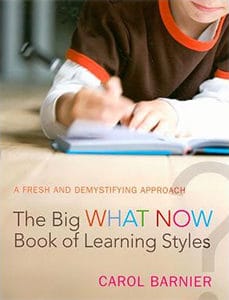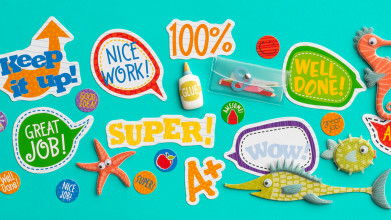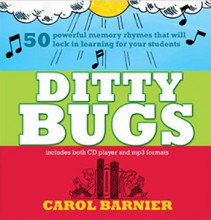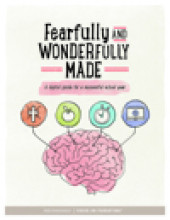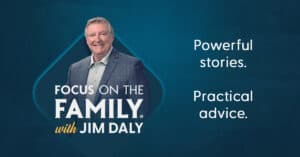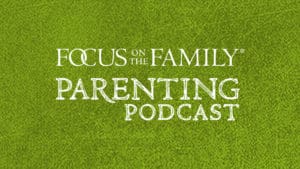Opening:
Mr. John Fuller: If there’s one child in the classroom who’s not doing well, who just can’t keep up with the homework, and doesn’t seem to be paying attention – any attention – who’s to blame? Parents and teachers often have this perspective.
Mrs. Carol Barnier: In fact, you’re the only one who seems to be struggling. And instead of both of us obviously concluding this method is not going to work for you, what we … where we tend to go is, “Well, since it’s working for so many others, you must be broken. There must be something wrong with you. You’re not trying. Maybe you’re lazy. Maybe you’re just not that bright.” You know, we go all these places we go, when the truth is, the kid just needs a different approach.
John: Some great insights from Carol Barnier. She has some profound ideas about kids and education. And she’s going to challenge your perspectives. Carol is back with us on today’s Focus on the Family and your host is Focus president and author, Jim Daly. I’m John Fuller.
Opening Wrap:
Jim: John, last time we featured a wonderful conversation that you and I recorded with Carol a few years ago. And the reason we’re bringing it back today is because so many of our listeners were enthusiastic about her message.
John: Yeah, a lot of response.
Jim: One mom explained that her daughter learns differently from her other children, and this broadcast was really helpful to her. A dad named Jeff said we gave him hope for his young son who struggles with reading. And another mom shared how much she loved the “ditties” or memory rhymes that Carol talked about, and she uses them with her own kids.
That’s exactly why Focus on the Family is here. We want to introduce you to great experts like Carol and offer you resources that will help you and your family thrive!
Carol is the author of The Big What Now Book of Learning Styles, which identifies 3 basic categories of learning: Visual — which most of us grew up with; Auditory — where you need to hear something to understand it; Kinesthetic — where you need some kind of motion while you’re learning.
Was that you, John?
John: No.
(Laughter)
Jim: And I know kinesthetic learners are the ones who often struggle in a school environment, because they want to tap their pencil or move their legs, or you know…whatever they’re doing. They’re movin’. And some educators (and parents!) see that behavior as disruptive, when they’re using it as a mechanism to help themselves learn.
John: Yeah, that’s really what helps them learn best. And Carol has further insights about figuring out what your child needs and helping them be successful. And let’s go ahead and hear part #2 of this very popular conversation with Carol Barnier on Focus on the Family.
Body:
Jim: Carol, we shared last time about your son, Glen, and how he wasn’t a good candidate for the traditional classroom and so, you homeschooled him, which I think is a great decision. But even that was frustrating because you really didn’t understand his learning styles at the time. Talk about working through those issues with your son. Your heart must have gone out to him as a mom and yet, you were resolved to try to find a way, the key, that would help open up his learning style. What happened?
Carol: Well, in the early days, it was all about putting motion into learning and that worked for him, but as he grew older and I think all kids have some kinesthetic component to how they learn. I think all kids like to move. But as he got older, he developed a strong auditory bent to his learning style and I missed that for a long time. And I’ll tell you where I caught it. We went to listen to a lecture. I paid good money for this lecture and I’m sittin’ there and I’m personally writing all these great notes down. I’m such a visual. I’ve got notes. I’ve got graphics, the white space matters, how it’s laid out on the page matters. And I look over at him and he is not writin’ down a thing and it ticked me off. I mean, I …
Jim: How old is he at this point?
Carol: At this point, he was probably about 12. And I like … I smacked him on the arm and I said, “I paid good money for this. Write somethin’ down.” (Laughter) And he said something that totally changed me. He said, “If I start writing, I’ll stop listening.”
Jim: Ah.
Carol: And it was a moment for me because it was so different from my own learning style. I had to step out of the box of how I learn and realize, this kid is made very, very differently and that’s when I started recognizing we need to incorporate auditory components to how I teach.
Jim: Well, and that can create some conflict between the parent and the child when your styles are different and you don’t recognize it. I could see that creating frustration.
Carol: And a parent’s natural inclination is to superimpose their own learning style on their child and to think, well, this must be how they learn, ‘cause this is how learning occurs and it is for us.
Jim: Right.
Carol: It’s really hard to step away from that, but once you do, you see that light bulb come on. You’re like, okay, all right, they’re different. I own it, now let’s go from here.
Jim: Hm. Carol, let’s give some hands-on help. Talk about spelling. Some children struggle with spelling. This can be challenging for any child but given all the inconsistencies in the English language — I’ve talked to foreign language students; they think English is so horrible and so difficult to learn. Talk about that. How can we equip a child to do well in spelling and writing skills?
Carol: Well, typically the approach that’s used to teaching spelling is to copy a list several times through the week and then they’re tested on Friday, which is great if the kid is a visual because seeing it all those repeated times, they’re gonna be fine. But you’ve got a kid who could see it spelled five different ways and they all look perfectly fine to him, this isn’t gonna be a helpful method.
So, there’s some things you can do. One is to get the pencil out of the child’s hand. A lot of kids just struggle with writing and then it kinds bleeds over into every other subject and they think they’re lousy at every subject, because they’re actually lousy at writing. So, one of the ways to do spelling without a pencil is to use Scrabble tiles. Just have ‘em in front of them and they can, you know, move them around and manipulate them and you can actually test them using Scrabble tiles.
Another one of my favorites is to use the Sign Language alphabet. It’s very, very kinesthetic. It doesn’t use the tiny, tiny little motor skills involved in writing. It’s also, here’s my word, it’s “kinesthetically memorable” because some letters of the alphabet, if they’re doubled, like in the word apple, you actually slide the letter. And so, it’s not a bounced A-P-P-L-E; it’s A, slide the P–L-E-. That is kinesthetic memorable. So anytime your child has a double consonant or a double vowel, that’s very helpful.
Another thing with spelling, an auditory click for spelling, is to do it in a way that involves a rhythm. So, everybody I know has spelled Mississippi, has used some kind of rhythm. You can do the same thing if you’re teaching them the word like “sophomore” and they’re all these O’s in it and it makes no sense to them and it should be a U-H instead of an O or whatever. So, you could have a rhythm like, S-O (Sound of snapping fingers), P-H-O, M-O, R-E. S-O (Sound of snapping fingers), P-H-O, M-O, R-E. I know it’s silly and simple, but that’s why it works.
Jim: Right.
Carol: You know, that’s the kind of thing that’ll click, so that’s just several ways to apply spelling.
Jim: Sure, it gives the brain a track to run on. That’s what you’re talking about. You also have tips for writing, Explain why you believe we need to offer more encouragement–I think it’s self-evident–but more encouragement and less correction to the papers our students, our children, are writing.
Carol: I really encourage parents and teachers, as well, to focus on one thing at a time in correction. Don’t give them a page back that’s awash in red. Maybe work on one or two grammar items or one or two writing items and work on those until they’ve mastered it. Then work on another item in the next go round, because they can be overwhelmed by feeling there’s nothing of value. The other thing I recommend is, not just giving them correction, but giving them what I call “an evaluation,” where you tell them the good stuff you found, because if you don’t say this is good stuff, then they’re pretty sure there’s not.
Jim: (Laughing) Yeah—
Carol: And they need to hear it.
Jim: –that’s for sure.
John: And you know the story that comes to mind for that, Carol, is that Dena was working with Zane on a school paper and he does not like writing. And he put some thoughts down and she challenged him and encouraged him, and he reordered some of it and put a little more detail down. And lo and behold, he got a 100 on it. And she used that as positive reinforcement.
Jim: Sure.
John: See, you hated doing more than you had to, but you did a great job there. We’ve gotta pick up on those little accomplishments to give them some motivation, don’t we?
Carol: Yeah, absolutely, because they’re gonna define themselves by their worst test and it’s up to us to help them see the balance in that view.
Jim: Hm. Carol, talk about math. Math can be so difficult. How can we make it more fun? It almost sounds silly saying it that way. How do we make math fun?
Carol: I think math and fun, those words should be in the same sentence regularly!
Jim: Good for you, girl! (Laughter)
Carol: I believe that. I believe that. Well, you can certainly play games. I mean, that’s an easy thing to do. One of the simplest ones is, you know, that card game “War,” where—
Jim: Yeah.
Carol: –you flip over the top two cards. Well, instead of each of you flipping over one card, flip over two and then the greatest sum takes that hand. Of if you’ve got a kid who’s a little bit older, the greatest product. Multiply the two cards together–
Jim: So, it—
Carol: –in that hand.
Jim: –makes them think.
Carol: So, it makes them think. And not only did I have my child tell me what the sum of his card was, I’d say, “Okay, what’s the sum of my cards?” I made him do double the duty. He had to tell me who won and had to take a look at that.
If you’ve got a child who just gets sloppy because they’re in a hurry or they really don’t want to be here, I would hand them some colored pencils or some colored markers and say, “Now I want you to go through this math problem and mark every plus sign with a certain color, every minus sign with another color and so on with multiplication and division, forcing them to stop and pay attention to the operations that are involved in this equation, ‘cause a lot of kids add everything, even though there’s a subtraction sign, just because they didn’t stop and think. And this is just something to add to the process and visually marks it, as well, for them to think through the process.
Jim: Carol, let me talk about your … what you call the “oral review,” ‘cause again, I’m applying this, John. I don’t know if you’re doing this but I’m just thinkin’ through my own children and how this would apply. Talk about oral review and what you mean by that and how that can help a child succeed.
Carol: You can use this method all the way along, from the earliest, earliest ages, where you would say to a child, “Okay, Mommy wants you to go set the table and put the forks and knives out.” Now what is it that Mommy wants you to do?” (Laughter) And then they repeat it back to you. Then when you’re getting into early reading, you start reading them a story and you say, “Now tell that back to me. Tell me what happened in that story.”
It’s actually gotta … there is an education term. It’s called “narration” and narration is just a process of a child learning to verbally put these thoughts together in their head and get them out of their mouths. It’s actually a pre-writing readiness activity. Because if they can think it through and articulate it well, then the next step of writing it down is much, much easier. So, all the way along, we need to have kids practicing that. Now if you’ve got a kid who’s struggling with details, it might be good every night when they came home to say, “Okay, here is what I have to do.” I would add to that, have them stand at the white board and make a list and tell me. I would maybe even add, okay, give me a graphic that reminds me. If you have to run out of the door with your gym socks, then draw some socks for me, something that might be a graphic reminder for a kid who’s more visual.
Jim: Huh. Talk about motivation for a moment though, because I think that would be another struggle that a lot of parents face, making education interesting, that’s … if you can achieve that, you‘ve done a lot. What about the child that is feeling, you know, not invested? They’re not that interested. They like playing with Legos more than doing other things, more academic things. How do you motivate a child to get up at the white board and write down all their assignments? I mean it sounds almost too perfect. ‘Cause some children are gonna say, “I don’t really want to do that, mom.” What do you do?
Carol: I think when a kid is uninvested, that what’s actually happening is, they’re worried they can’t cut it, so they’ve stop investing. And it may be hard to reclaim that investment from them but I am absolutely convinced that if a kid believed that by doing these things, he would ace next week’s test, you could get him to reinvest. So, you’re gonna have to show him, maybe in smaller increments that this stuff works and that he can start becoming the student that you know he’s capable of being.
Jim: Carol, with the end in mind, let’s talk about those success stores that you’re aware of, where children who were failing, weren’t learning, ended up making it. I think a lot of parents are desperate to hear that, so let’s start there.
Carol: Well, one of my favorite stories came from a gentleman who was a headmaster at the local private Christian school in our area. And he was very ADHD himself and we were discussing, you know, some of the struggles of my son and he said one of the best things that happened to him when he was in his PhD. program, he was possibly failing. I mean, he was about … he was poised to absolutely fail. And his advisor took him aside and said, “Stop writing. You are struggling with the act of writing, but you can think. You can articulate. You have great, great reasoning abilities. Take a recorder and just record your work, then later on transcribe it.”
And he said it absolutely saved his career because the process of thinking and speaking and then writing, they’re very different parts of the brain that are at work. And once he was able to separate those, he said, “Transcribing was nothing.” You know, you hit it and then you hit pause. You don’t have to remember what it was; you’re just gonna transcribe it. And he goes, “And now of course, I make enough money that someone else transcribes for me.
Jim: (Chuckling) Right.
Carol: But yeah, for him it was all about getting it in its auditory form. That’s where his strengths were and when he separated it, that’s where he was able to succeed.
John: Hm.
Jim: You talk about the idea factory. Talk about that. What do you mean by the “idea factory?”
Carol: Everybody has this place where they just are kind of open; their mind opens up and they’re able to think and create and they just find all of these ideas. I swear to you, for my husband, it’s in the shower. I’m convinced (Laughter). I mean, he has … I almost think there’s like eight people in there with him, ‘cause he’s havin’ all these conversations and he’s thinkin’ things through and hearing how they sound. And he always comes out of the shower goin’, “I got three great ideas” and he’ll go and write them down. So, everybody has one of those places. And so, try and figure out. Try your kids in different things and try yourself in different things. Maybe it’s listening to music. Maybe it’s taking a walk. For my father, it was gardening. That’s where he got his ideas. He was a gardening guy. And when you find your idea factory, then incorporate that into how you like allot your time, so that you have those creative moments that you need.
Jim: That’s interesting. Where’s your idea spot, John?
John: That’s probably as I drive. Road trips for me—
Carol: Yeah.
Jim: Yeah—
John: –are the moments—
Jim: –I’ve seen—
John: –that I get—
Jim: –that.
John: –space.
Jim: That’s a good one.
John: The miles click away—
Jim: Yeah.
John: –and I just have time to process and think.
Jim: I’d be similar.
John: The big difficulty with that is, I can’t take notes while I’m driving.
Jim: Yeah.
John: So, I’ve gotta remember—
Jim: You dictate.
John: –all those ideas.
Carol: Digital recorders.
Jim: That’s right.
Carol: That’s what I take with me when I drive because I have 30 good ideas. I will remember two, so I have a digital recorder and I’m just—
Jim: Well, that’s a great idea.
Carol: –constantly … in your cell phone probably now would allow you to do that.
John: It does.
Jim: Those are good.
John: It does do that.
Jim: Those are good ones.
John: Well, good idea. This is “Focus on the Family” with Jim Daly. I’m John Fuller and we’re reviewing a conversation with Carol Barnier about how to help your child learn and experience education in fun ways. Contact us about getting an audio copy of this entire 2-day conversation with Carol, and The Big “What Now?” Book of Learning Styles that she wrote. Call 800-A-FAMILY to learn more or stop by focusonthefamily.com/broadcast.
Alright, here’s the conclusion of our conversation with Carol Barnier on Focus on the Family.
Jim: Carol, let me paint a picture for you and speak to this mom, because I think a lot of times moms feel so much more deeply than dads. I mean, dads are kinda like, pick yourself up; brush yourself off; let’s keep movin’, right? And I know this is a generalization, so if you’re not that kind of dad, I get it.
But for moms, and I think for Jean – she would say this is true – they tend to worry more about where their children are at, not seeing kind of that studious child that they hoped they would be, whatever it might be. Speak to that mom’s heart and the idea that you use humor. You talk about the importance of humor in the educational process.
So, there’s all these complex things. Use humor. Be light-handed, but make sure they’re disciplined and gettin’ their work done. I mean these are somewhat contradictions but talk to that mom who’s got a heavy heart. Talk to her, counsel her, on how she can approach a difficult learning situation.
Carol: I know moms are so invested in their kids. I just … there’s no place where our heart is thinnest than when it comes to our kids, you know. So, I get that. What I would recommend to any mom is, you’re dealing with a whole person here. You’re not just dealing with an academic success or failure. So, remember the whole child. Connect to them. It doesn’t always have to be about learning. It doesn’t always have to be about correcting their character. It doesn’t always have to be about, you know, this sin in their life. Sometimes we just need to laugh and tell knock-knock jokes and take a walk in the park and—
Jim: Breathe.
Carol: –and breathe and laugh and remember that God put this child in your family to parent, not just to teach. And parenting is so much bigger of a task. Just … I think loving this child as a whole will pay off when they get older and if they struggle with various things. It’s easy to really focus on the thing they’re struggling with. And that is losing out on the bigger picture of who they are. And frankly, something God does with us all the time. If all He did was remember me by my failure yesterday, I am so in trouble! But thankfully, He sees the whole picture.
Jim: Uh …
Carol: So, we need to remember, too, that God has a plan for this child and that plan isn’t perfected until the day of Christ Jesus. He’s still workin’ on this kid. It doesn’t all have to be put together and fixed by tomorrow.
Jim: Wow, that is … I mean, that is so important for us as parents to know and I think particularly, Christian parents, because we have such high expectations and kids feel it. They feel that pressure. They know that we’re hoping the best for them and we want them to hit those top notes when it comes to academics.
Jim: Carol, you list at the end of your book, Things Kids Wish You Knew About Learning. Talk through some of that list, those things that kids wish that we parents knew about learning.
Carol: Yeah, this was one of my favorite sections to write about. One of the first items you’ll find there is that slow isn’t stupid and I learned this the hard way. I have this one daughter, who is not ADHD. I … I’ve said for years, she’s the only reason I let the other two kids live. (Laughter) She was so easy. I … I could just … I could’ve thrown the textbooks at her and she would’ve learned anyway. But she thinks very methodically. And I thought for a long time she was gonna be my average kid and that was okay. I loved her dearly, but she wasn’t a fast talker and a fast thinker and you know, and … and I can come to equate that with being bright. And so, one day we went through the testing that was involved in our state and … and they … her scores came back and she’s like 99th percentile.
Jim: Hm.
Carol: Not just in achievement, but in ability. And I kinda had to sit down and go, how did I miss this? And I needed to start really, you know, upping my game in challenging her. But what I came to realize was, she is an analyzer and she keeps things close to the vest. And she thinks very methodically. And she does not open her mouth and share until she has come to a complete conclusion. And I had mistaken that silence as not being as bright. So, I just recommend that all teachers and parents, watch for that and don’t assume that this is a kid who’s not bright. Assume that they are a uh … an analytical thinker.
Jim: Yeah.
Carol: They’re the …
Jim: You’re talking in terms of temperament it sounds like, too, so you have learning styles and then you have a temperament that your child possesses. Talk about that intersection.
Carol: And … and it’s not that the temperament, it’s a type of intelligence. If you have someone who’s really strong in say the math and sciences, they’re often surprisingly weak in the language and … and those kind of skills—re … spelling and—
Jim: Right.
Carol: –reading and writing. And if you have someone who’s strong in the reading and writing, they often are weak in the math and sciences. And it’s not that either one of them isn’t bright. It’s that there are different types of intelligences at work here. And that’s why an awful lot of doctors have horrible handwriting and can’t spell!
Jim: Right.
Carol: You know, we … we … we tend to think of … of spelling and handwriting as being this bellwether or whether or not a child is doing well and I’m thinking, well, then every doctor I know must be an academic failure and of course (laughter) we know that’s not the case.
Carol: So, there are different types of intelligences. But there are also different types of temperaments and that … that gets into, you know, is your child very social or do they prefer to learn to work alone? Do … do they want to be up and moving? Or do they want to really be focused on … on a … you know, a dot in front of them while they … while they read? And I … I think you do have to like take those things into account. My whole theory is though, try different things.
Jim: Right.
Carol: Try wildly different things. Try things that would never have worked for you. Step so far out of the box that you’re thinkin’, this is crazy and see what works.
Jim: Carol, you talked about that key. Talk about some of the successes in parents that you’ve helped coach. But talk about the keys that they have discovered.
John: Hm.
Carol: One good example is, if you’re working with a child who learns their math facts through flash cards and you know, the kids come along and they’ve got that visual cue and all these need is enough repetition and they get it. And then suddenly you’re dealing with another kid and they are three years into flash cards and they are still not getting’ their math facts. Well, this is where you need to flip and get away from that visual one and maybe go to skip counting where they’re using some kind of auditory, you know, (Singing), two, four, six, eight 10, 12 and 14 …” something like that.
And I’ve heard time and time again where parents get stuck on the flash cards and then when they finally switch over to the auditory skip counting, they’ve got it. And that was exactly what happened in my house. I had a girl three years (Chuckling) we were doing these math facts and I thought, this worked for your brother and sister. It’ll just take a little more time and like year one, I bought that. Year two, I’m thinkin’, okay. Year three, I mean, I just kept going at it with the wrong approach. And finally, I said, “You know, Carol, you know this stuff. You know it’s time to shift gears.”
Jim: Huh.
Carol: And she had (Sound of snap of fingers) it like that.
Jim: That’s amazing and what I’ve heard throughout our discussion is have versatility. Don’t get locked in and don’t wait. You know, if it’s not workin’, make a move. I think I would try to keep plowing the hard ground, rather than find ground that’s more plowable.
Carol: Well, I’ll tell you my favorite response to that is, if I said to you, I mean, typically we’ll say to our kids, three minus two equals one. And if they don’t get it, we’ll say it again. If they don’t get that, we’ll say it louder. If they don’t get that, we’ll say it slower. (Laughter) But if I said to you, you know, that a seven “schnoodled” by a two will “grovinate” into a 16. (Laughter) Now if I said it to you louder or slower or 20 more times, will it get you anywhere?
Jim: I don’t know what you’re talkin’ about.
Carol: And the answer is no. Until I explain “schnoodled” or “grovinate,” we’re not goin’ anywhere. So, sometimes when you keep pounding away with the exact same approach and the exact same wording and they’re not getting it, more of nothing is nothing! We have to come at it from a different angle or this kid’s gonna get stuck.
Jim: Talk about that parental frustration. And we’ve seen it in our own experience at home. You can if you’re not careful, you can lose it as a parent. You do get frustrated and the child’s pickin’ that up. They don’t know where to go with that.
Carol: Yeah.
Jim: How do you better manage that? Coach the parent on how to take that deep breath and say, “Okay, try somethin’ new.”
Carol: It comes back to the keys. I’m going to present to my child my explanation of maybe fractions or whatever it is they’re working and they don’t get it. So, I got … I got one more key in my pocket. So, I pull it out and I present it and they still don’t get it. This is where most parents get frustrated, ‘cause they’re like, “Okay, I’ve explained it to you every way I know how. Okay, if you’re not getting’ this, I don’t know what else to do.”
Jim: And they’re saying in that, the parent is saying that, “I don’t know where to go.”
Carol: Right. That is where they step back and they go, “You know what? I’m gonna find another key. I don’t have it right now but I’m gonna go find another key.” And everybody can take a step back and it says to the child, “We’re not done here. You’re gonna get this. It’s not a question of if; it’s just a question of when and we’re gonna go find the method that works for you.” And you get on the Internet and you talk to teachers and you get books and you ask around and you can find other keys to try with this child. But that frustration point, everybody gets there when they’ve run out of their own keys. Just step back.
Jim: Yeah, that is good.
John: And this is not an uncommon thing. I think too many parents, Carol, feel like I’m the only one who’s struggling with my child in this way. It’s pretty common, isn’t it?
Carol: Very common. In fact, I’m guessing it’s universal at some point in a child’s, you know, upbringing.
Jim: Carol, let’s end with this important question. What is the most important thing we as parents can do to help our children succeed at learning which is the core thing?
Carol: The most useful thing I think is to own the fact that they can learn if we just provide the right key.
Jim: Hum…
Carol: And that once that’s found they’ll be fine. But if we believe that they can’t learn, they’ll believe it, too. They’ll be right behind us in that belief, so it can never be a part of the equation. They have to know that we are fully invested in the idea that when we find the right approach, they will learn.
Jim: Carol, you know that advice is so good in our Christian faith, as well, isn’t it? When we’re talking to people? I mean, that just struck me. That it’s about finding the right key. The Lord has given us a set of keys and He’s just saying, pick the right one in that situation where you can communicate with your children, with your spouse, with your family members. It is always about the right key, isn’t it?
Carol: Right and He’s made us all so differently, so the keys are going to be different and instead of trying to make our kids all look and walk and talk the same, we need to open up the gift that He has put in this child and figure out what He’s got in mind for them in how they learn.
Jim: Carol, thanks for being with us.
Carol: Thank you so much for having me. It was a delight.
Closing:
John: And that’s how we concluded our conversation with Carol Barnier on Focus on the Family. Your host – Jim Daly. I’m John Fuller.
Jim: Well, it’s my hope, John, that many moms and dads were encouraged by what Carol shared these last couple of days, John. And that you, the listener, will get a copy of The Big What Now Book of Learning Styles.
Now, it may be that your kids are in a good place, education-wise, and you don’t really need a resource like this. But I’ll bet you know of a family who is struggling. And what a great ministry, just to keep your eyes open looking for those parents that might need some help. In fact, we hear from a lot of parents who are dealing with some kind of challenge or crisis in their families — hundreds of thousands every year. But thanks to the generosity of friends like you, Focus on the Family is strategically placed to bring hope and practical help to these moms and dads. And let me say “thank you” to our friends for that valuable support.
And I’d like to invite you to join our family building team. By making a monthly pledge today, you will enable us to reach more hurting families and bring them the resources they need to thrive. Even a one-time gift is helpful for someone in need. So, please, be generous with your giving to Focus on the Family today.
Closing Voice Track:
John: We really are counting on your support, so please, donate online at focusonthefamily.com/broadcast. Or call 800, the letter A, and the word FAMILY.
And if you can make a monthly pledge, or a generous one-time gift of any amount today, we’ll say “thanks” by sending a complimentary copy of the The Big What Now Book of Learning Styles by Carol Barnier.
Be sure, as well, to look for details about our Thriving Student podcast. It’s a six-part series where we’ll help you raise healthier kids emotionally, physically, socially, and spiritually. It’s a great back to school resource for your family. And we’ve got details, and a link, at focusonthefamily.com/broadcast.
Now, coming up next time you’ll hear the incredible story of Christian musician, Russ Taff. He’ll be describing his abusive childhood and how God transformed his life.
Mr. Russ Taff: The most damaging thing that happened to me and my brothers daily – “You’re not worth the bullet to shoot you with. You’re not worth the salt that goes on your bread. You will never amount to anything.”










